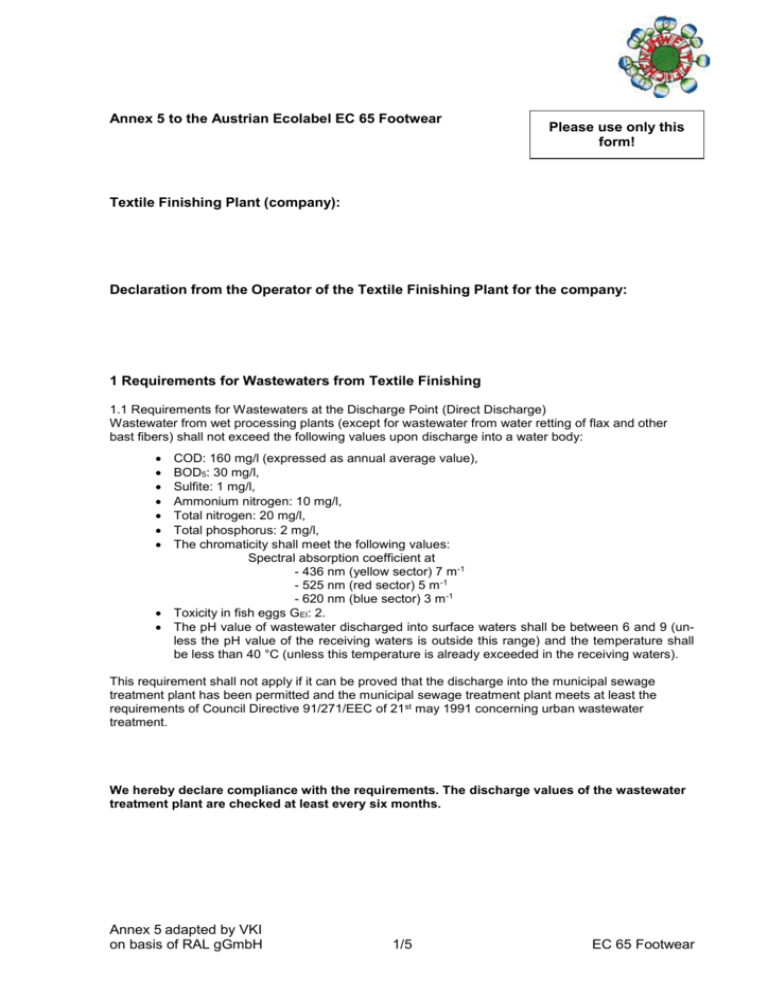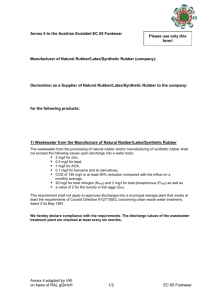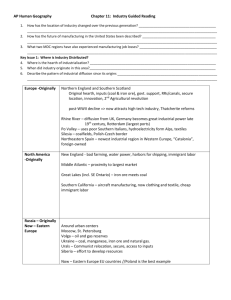1 Requirements for Wastewaters from Textile Finishing
advertisement

Annex 5 to the Austrian Ecolabel EC 65 Footwear Please use only this form! Textile Finishing Plant (company): Declaration from the Operator of the Textile Finishing Plant for the company: 1 Requirements for Wastewaters from Textile Finishing 1.1 Requirements for Wastewaters at the Discharge Point (Direct Discharge) Wastewater from wet processing plants (except for wastewater from water retting of flax and other bast fibers) shall not exceed the following values upon discharge into a water body: COD: 160 mg/l (expressed as annual average value), BOD5: 30 mg/l, Sulfite: 1 mg/l, Ammonium nitrogen: 10 mg/l, Total nitrogen: 20 mg/l, Total phosphorus: 2 mg/l, The chromaticity shall meet the following values: Spectral absorption coefficient at - 436 nm (yellow sector) 7 m-1 - 525 nm (red sector) 5 m -1 - 620 nm (blue sector) 3 m -1 Toxicity in fish eggs GEI: 2. The pH value of wastewater discharged into surface waters shall be between 6 and 9 (unless the pH value of the receiving waters is outside this range) and the temperature shall be less than 40 °C (unless this temperature is already exceeded in the receiving waters). This requirement shall not apply if it can be proved that the discharge into the municipal sewage treatment plant has been permitted and the municipal sewage treatment plant meets at least the requirements of Council Directive 91/271/EEC of 21st may 1991 concerning urban wastewater treatment. We hereby declare compliance with the requirements. The discharge values of the wastewater treatment plant are checked at least every six months. Annex 5 adapted by VKI on basis of RAL gGmbH 1/5 EC 65 Footwear Attached hereto are test reports substantiating compliance with the requirements according to Annex 38 to the German Wastewater Ordinance or equivalent international test reports. For this purpose, the following test methods may be used: COD: ISO 6060 or DIN 38409-41 or DIN ISO 15705 for the qualified random sample or the 2-hour mixed sample, Sulfite: DIN EN ISO 10304-3, Toxicity in fish eggs: DIN EN ISO 15088, AOX (chloride content < 5g/l): DIN EN ISO 9562, AOX (chloride content > 5g/l): DIN 38409-22, Spectral absorption coefficient: DIN 38404-3, Ammonium nitrogen: DIN EN ISO 11732:2005, Total nitrogen: DIN EN ISO 12260, Total phosphorus: DIN EN ISO 11885, Attached hereto are a permit of a municipal sewage treatment plant and a document evidencing that the sewage treatment plant meets at least the requirements according to 91/271/EEC. 1.2 Requirements for Wastewaters prior to Mixing (Direct and Indirect Discharge) Prior to mixing with other wastewaters the wastewater shall not exceed the following values: AOX: 1 mg/l, Sulfide: 1 mg/l, Copper: 1 mg/l, Nickel: 0.5 mg/l, Total chromium: 0.5 mg/l, Tin: 2 mg/l, Zinc: 2 mg/l Attached hereto are test reports substantiating compliance with the requirements according to Annex 38 to the German Wastewater Ordinance or equivalent international test reports. For this purpose, the following test methods may be used. Copper and nickel: ISO 8288, Sulfide: DIN 38405-27 or ISO 10530, AOX (chloride content < 5g/l): DIN EN ISO 9562, AOX (chloride content > 5g/l): DIN 38409-22, Tin: DIN EN ISO 11885, Zinc: DIN EN ISO 11885. As an alternative to measuring the copper, nickel and chromium contents it is hereby declared that metal complex dyes containing copper, chromium or nickel do not form part of the dyeing formula. Annex 5 adapted by VKI on basis of RAL gGmbH 2/5 EC 65 Footwear 2 Requirements for Exhaust Air Emissions in Textile Finishing Total organic substances as total carbon shall not exceed 0.8 g C per kg of textiles during the thermosetting, thermosoling, coating, impregnating or wet finishing of textiles, including the respective drying facilities. An additional maximum of 0.4 g C per kg of textiles may be emitted from carry-overs from upstream processes and residual contents of preparations each. We hereby declare compliance with the requirements. Attached hereto is a report according to Appendix 2 including a projection of emissions on the basis of substance emission factors. Attached hereto is a test report according to DIN EN 12619. When testing according to DIN 12619 the product-related emission factor is determined from the measured concentration value and the actual air/product ratio. The calculation formula, including an example calculation, can be seen from Appendix 2. Place: Date: Annex 5 adapted by VKI on basis of RAL gGmbH Signature: (scanning is possible) 3/5 EC 65 Footwear Appendix 2 to the Basic Criteria UZ 65 Footwear Calculation of Exhaust Air Emissions in Textile Finishing The substance emission factors shall be made available by the manufacturer of textile agents as product information. The substance emission factor is defined as the amount of substance in gram that may be emitted under defined process conditions (curing time, temperature, substrate) from 1 kg of textile auxiliary. 1. Calculation of the product-related emission factor from substance emission factors: WFC = Σ(FA x FK x fC) THM: Textile auxiliary WFC: Product-related emission factor in g of total organic carbon per kg of textile material FA: Liquor pickup in kg of liquor per kg of textile material FK: Liquor concentration in g of textile auxiliary per kg of liquor fC: Total carbon substance emission factor in g of total organic carbon per gram of textile auxiliary Calculation of Product-related emission factors of two formulas (by way of example): FK FA fC FK x FA x WFC Liquor Textile Auxiliary [g/kg] [kg/kg] [g/g] fC 20 0.65 0.2 Polysiloxane 20 0.65 Reactant crosslinking agent with catalyst. Stearyl urea derivative with catalyst 100 0.65 20 0.65 0.015 2 0.005 2 0.000 9 0.016 2 Formula 1 Fatty acid ester Total 1 Formula 2 Plasticizer Crease-resistant finish, formaldehyde-free Catalyst Total 2 Annex 5 adapted by VKI on basis of RAL gGmbH [g/kg] 0.07 0.06 0.21 0.54 50 12 1 1 0.005 0.010 0.25 0.12 12 1 0.008 0.1 0.47 4/5 EC 65 Footwear 2. Calculation of the Product-Related Emission Factor from the Measured Concentration: Firstly, the air/product ratio (LWV) in m³/kg is calculated from the measured waste gas flow (V) (in m³/h) of all emission points of a thermal treatment unit and the product throughput (W) (in kg/h): LWV = V/W If more than one thermal treatment units are connected to a waste gas cleaning plant the weighted LWV will have to be determined by dividing the total waste gas flow by the total product throughput. WFC = LWV x Σ cC THM: Textile auxiliary WFC: Product-related emission factor in g of total organic carbon per kg of textile material LWV: Air/product ratio in m³ waste gas per kg of textile material cC: measured concentration in g of total organic carbon per m³ of waste gas Annex 5 adapted by VKI on basis of RAL gGmbH 5/5 EC 65 Footwear






